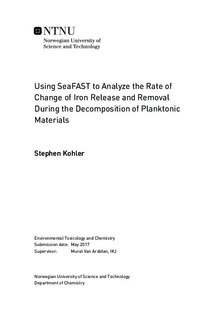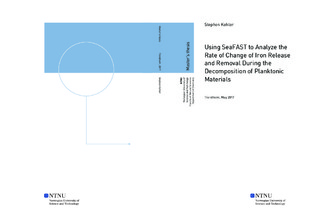| dc.description.abstract | The cycling of iron in the ocean plays an important role within both the biological carbon pump and the nitrogen cycle. As much of primary production in the euphotic zone depends upon the internal recycling of iron, the effect of biotic and abiotic processes on the remineralization, or solubilization, of this essential trace metal from decomposing organic matter must be explored. Part of the Ocean CERTAIN project, this thesis aimed to assess the release and change in concentration of iron in the decomposition of varying natural communities from the oligotrophic Cretan Sea. A mesocosm experiment consisting of natural seawater communities was amended with increased zooplankton concentrations and an increasing carbon gradient. Upon completion of the mesocosm experiment, seawater was transferred to dark bottles for community decomposition where time-based sampling for total dissolvable iron, dissolved iron, and macronutrients was taken. Analysis of iron samples was done with SeaFAST, a commercially available preconcentration system available through ESI. Instrument parameters were assessed for recovery and accuracy while quantification was done via ICP-MS. Recovery of iron within the SeaFAST system varied between 84-101%, most likely affected by a combination of background iron levels, SeaFAST elution volume accuracy, and post-preconcentration storage, emphasizing the proper cleaning and evaluation of SeaFAST parameters prior to any sample analysis. Iron concentrations over time in dark bottles showed an initial increase, consistent with remineralization. Tanks with different grazing treatments did not show statistical significance in initial rates of change, and the highest carbon gradient group initial rate of change was statistically different from only one other group. A subsequent decrease in rates of change of dFe and decrease in TFe concentrations for all tanks suggested high adsorption was occurring within the bottles and that the release rate of iron within dark bottle decomposition experiments may follow a non-linear rate of change. A non-linear release rate implicates the importance of both abiotic and biotic mechanisms for iron recycling, and that models of iron remineralization will likely need to incorporate both processes to accurately predict dissolved iron concentrations within varying aquatic communities. | |

